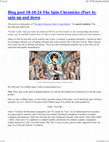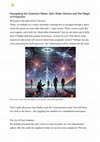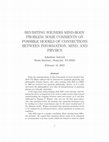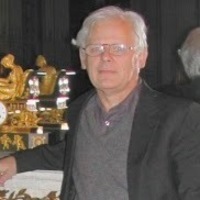Drafts by Arkadiusz Jadczyk
This post is a continuation of The Spin Chronicles (Part 9): Matrix representation of Cl(V).
Biquaternions algebra introduced via Cl(3).
This post is a continuation of "The Spin Chronicles (Part 5): Exterior algebra of space", and we ... more This post is a continuation of "The Spin Chronicles (Part 5): Exterior algebra of space", and we will keep the notation introduced therein. But first a little historical interlude.
The document is a draft and may have typos. For the actual corrected version please check the linked web site.
The exterior algebra of space is realized as the space of multivectors using Kronecker deltas.
There’s no shortage of theories trying to explain the mysteries of quantum mechanics, and conscio... more There’s no shortage of theories trying to explain the mysteries of quantum mechanics, and consciousness often gets dragged into the mix. Some even claim it has a special role in state vector reduction—those quirky “quantum jumps.” Roger Penrose is one such advocate, but he’s not alone. When you ask these consciousness enthusiasts if physics behaves differently on the far side of the Moon (where no one’s watching) or if atoms over there just stop jumping, the answers get...let’s say, "evasive."

This post is a continuation of "The Spin Chronicles (Part 3): Spin frames". It is purely technica... more This post is a continuation of "The Spin Chronicles (Part 3): Spin frames". It is purely technical. This previous post ended with: "In other words, when you rotate an element of O(V) by an SU(2) matrix A, the corresponding lab element rotates, too, by and SO(3) matrix R(A). It's like a cosmic interlock between spinors and real-world rotations." Today we will see how this can be realized, and, in fact, is realized, in quantum mechanics. I should say that I am not happy with this way of dealing with spin, but, at the moment, this is the best I can do. What I present here is just one way of dealing with spinors. There are other formulations possible, but, in fact, they are all equivalent and equally unsatisfactory. I should say that I am not happy with this way of dealing with spin We will treat V as a Hilbert space, with its scalar product (u|v). Note: Here, more in the spirit of quantum physics we will use the notation (u|v) instead of (u,v) for the scalar product.
This blog post introduces a baby spin structure for 3D space.

Welcome to the Spin Vector Universe Today, we embark on a cosmic adventure, learning how to navig... more Welcome to the Spin Vector Universe Today, we embark on a cosmic adventure, learning how to navigate through a space where the points are none other than spin ½ state vectors. These vectors, much like secret agents, carry both the "observable information" that we can detect and a hefty dose of hidden data that remains mysterious-at least for now. Who knows what tomorrow's physicists will uncover about these enigmatic vectors? Perhaps one day, even consciousness itself (and even "psi" phenomena) will be written into the math. These vectors, much like secret agents, carry both the "observable information"... That's right, physicists may finally crack the "consciousness code," but until then, let's stick to the basics-like juggling four numbers in a multidimensional space. The Joy of Four Numbers We initially presented the state vector as a pair of points on a two-dimensional sphere. But why settle for simplicity when we can dive into complexity?
Digging into the geometry of spin 1/2.
Blog post, 2024
This note discusses de Vries' formula for the fine structure constant.
In this post we explore the enigmatic journey of Swiss mathematician Armand Wyler, who attempted ... more In this post we explore the enigmatic journey of Swiss mathematician Armand Wyler, who attempted to unravel the fine structure constant, alpha, related to the number 137. It delves into historical attempts by physicists like Sir Arthur Eddington and Wolfgang Pauli to understand this dimensionless constant, connecting quantum theory, relativity, and electromagnetism. The post also highlights Wyler's geometric interpretation and the profound yet tragic impact of his work, which led him to a psychiatric clinic.
Infinite Wonders: The Journey and Factory of Prime Numbers, 2024
Prime numbers, those elusive building blocks of mathematics, have captivated minds from ancient E... more Prime numbers, those elusive building blocks of mathematics, have captivated minds from ancient Egypt to modern academia. With Euclid's timeless machine, we've shown that the hunt for primes is a never-ending adventure. As mathematicians continue to unravel their mysteries, who knows what prime secrets await discovery? So, next time you ponder numbers, remember: there's always another prime just around the corner.
For each quadratic form Q ∈ Quad(V) over a given vector space over a field K we have the Clifford... more For each quadratic form Q ∈ Quad(V) over a given vector space over a field K we have the Clifford algebra Cℓ(V, Q) defined as the quotient T (V)/I(Q) of the tensor algebra T (V) over the two-sided ideal generated by expressions of the form x⊗x−Q(x), x ∈ V. In the present paper we consider the whole family {Cℓ(V, Q), Q ∈ Quad(V)} in a geometric way as a Z2-graded vector bundle over the base manifold

From the announcement of this Convention we have learned that 2019 J.B. Rhine address will be del... more From the announcement of this Convention we have learned that 2019 J.B. Rhine address will be delivered by quantum physicists and philosopher Antoine Suarez, who, after meeting John Bell at CERN in 1988 got involved into quantum philosophy. Suarez, as it is said, advocates the philosophical view that all interpretations of quantum physics are basically equivalent. I will argue that understanding John Bell's real concerns, and following his advice is important if we want to make serious steps toward understanding the coupling between mind and matter as it was first addressed by Eugene P. Wigner, who was one the first great physicists who speculated that the message that quantum mechanics may be sending us is that consciousness may be the most essential part of the ultimate reality. Wigner envisaged that quantum mechanics needs to be replaced by an enhanced theory, whose equations of motion are nonlinear. John Bell came to a similar conclusion albeit starting from different premises. He argued that quantum theory needs to be enhanced to accommodate real time events (which he related to what he called 1 "beables"-things that really "are"). What is needed is explicit description , within the mathematical formalism of quantum theory, of the flow of information. I will argue that this can be done. I will argue that in order to understand and to describe, using equations and algorithms, consciousness and psi phenomena, in particular of poltergeist type, further steps are necessary that involve hyperdimen-sional physics and Kaluza-Klein type theories but developed for low energy phenomena and information exchanges, which is not how contemporary theoretical and mathematical physics is being developed.
Papers by Arkadiusz Jadczyk
Preprint of University of Wroclaw, ITP UWr, 1988
Events and Spontaneous Localization Models, 1995
IFT Uni Wroclaw, internal report, 1993

Uploads
Drafts by Arkadiusz Jadczyk
https://ark-jadczyk.blogspot.com/2024/11/the-spin-chronicles-part-10-geometric.
The document is a draft and may have typos. For the actual corrected version please check the linked web site.
Papers by Arkadiusz Jadczyk
https://ark-jadczyk.blogspot.com/2024/11/the-spin-chronicles-part-10-geometric.
The document is a draft and may have typos. For the actual corrected version please check the linked web site.